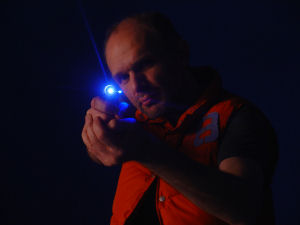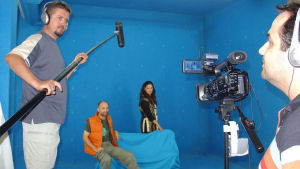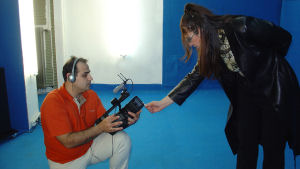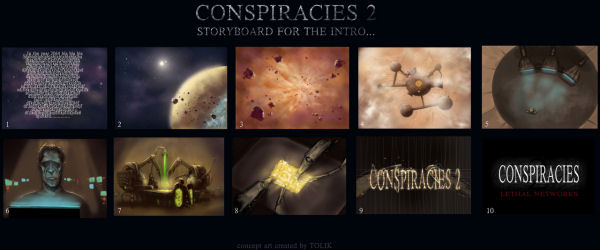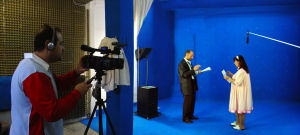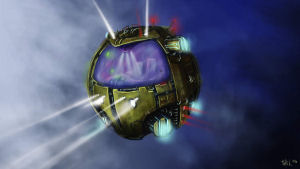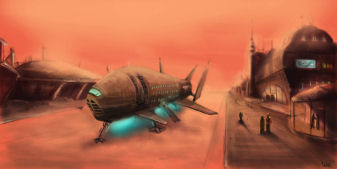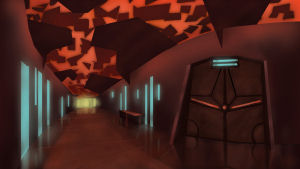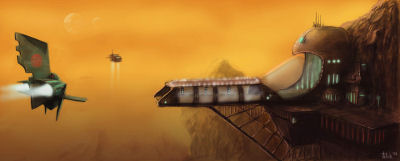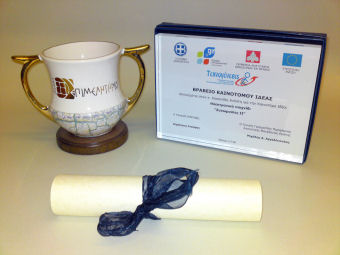|
Conspiracies II: Lethal Networks -- The Development Team Reveals All
Michael Georgoulopoulos (lead programer - engine developer), Agelos Vougas (Nick Delios), Anestis Kokkinidis (me :D), Marina Kokkinidou (my sister and scenario writer), Kostas Kalampokas (music score composer) and Tolis Polihroniadia aka Tolik (Concept Designer) |
|
Anima ppd-interactive is a developer located in Greece; the development team has just released its second game: Conspiracies II: Lethal Networks. A mystery adventure in a futuristic setting, Lethal Networks is the sequel to Conspiracies (released in 2003), which established Anima's credentials as innovators in the area of full motion video (FMV) based games. The intrepid Nick Delios from the original Conspiracies returns to take on another case with far-flung locations and far-reaching implications. How has Nick -- and the ultramodern world he investigates -- changed over the years? To find some answers, GameBoomers spoke to Anestis Kokkinidis, Anima's Project – Product Manager – CEO director, 3D artist and script programmer; Marina Kokkinidou – writer and scenario screenplay; Agelos Vougas - actor, gameplay and puzzles; Micahel Georgoulopoulos – lead programmer; Tolis Polihroniadis (Tolik) – concept designer; and Kostas Kalampokas – music composer.
1. There is an eight year gap between Conspiracies (released in 2003) and Conspiracies II: Lethal Networks (released in 2011). What kept you motivated and continuously working on the sequel throughout that time? -Anestis: Well to be honest, first of all it was our love for FMV adventure games and the fact that we had a great time doing Conspiracies which was also rather profitable for us. So at the end of 2004, after we had a good number of sales from Conspiracies (2003) we invested in the development of our new idea – and sequel – Conspiracies II – Lethal Networks. During the development, all looked fine and turned even better when we participated in a European Union technology innovation program contest called “Technogenessis” which awarded us with the third prize for our idea and also funded a part of our project. Things looked very promising at the time. And then, when we reached 90% completion of the work, disaster came. Our lead programmer quit, leaving us with ruined code that couldn’t be salvaged, and we had to start all over again with that part from scratch – building a real-time graphics engine. If this hadn’t happened, we would have launched Conspiracies II probably in mid 2008. Having all our work almost complete except the programming part (real-time engine), we decided that we could still make things happen. And then we found our new lead programmer, Michael Georgoulopoulos, who took things in his hands and was able to put into his new written code all the new technology, plus all of the work that had been done till then and to wrap things up in just 2 ½ years – all from scratch!
2. What sort of a person is the lead character, Nick Delios? How has he changed since Conspiracies? How do you expect gamers to react to him? -Marina: Nick Delios is a pre-constructed game character destined to become the real player’s virtual self in the story of the Conspiracies game world; players will perceive the Conspiracies or Conspiracies II-Lethal Networks “universe” through his eyes. Who is Nick Delios? Nick Delios is the “outsider”, the smart, misunderstood, wronged looser, clever but lazy, humorous and resourceful, who ends up saving the world, when nobody believes he has the ability or the “guts” to do it. His goal is to solve mysteries and disclose conspiracies involving crime and politics. His enemies are corrupt politicians, greedy businessmen, members of organized crime or small crooks, ready to risk Earth’s future for more profit and co-operate with hostile races from other parts of the Galaxy wanting to expand their influence. Nick Delios, when we first meet him, is a failed academic specializing in medical software, who works as a private investigator mostly in solving cases of industrial espionage (Conspiracies). After his success uncovering a major conspiracy against Earth, he becomes a governmental agent in Conspiracies II-Lethal Networks. Although he gains power and money, since he becomes the “hot-shot” of the Earth secret services, he remains the same old Nick! Hanging out with friends, spending money that he doesn’t have, forgetting to pay bills, are some of Nick's characteristics, along with his developed sense of humor that the player of Conspiracies II will recognize. At the same time Nick is now more self-confident, more fit to confront his enemies, due to his prior successes and (because of that) willing to put the past behind and even co-operate with his former friend and enemy Dimitris Argyriou. By playing Conspiracies II-Lethal Networks we would like our players to find again their “old friend”, Nick Delios and by being him to experience not a perfect self but a loose, humorous, playful and clever self, full of flaws but also with potential, to have lots of fun trying to save Earth and maybe think a little more about our own world, which is not very different from the one in Conspiracies…
3. There was a stretch of time where it looked as though developers were abandoning full motion video (FMV) in adventure games. Do you think the FMV format is staging a comeback? Is it easier to work with FMV now than it was in 2003? -Anestis : FMV was, and is, always difficult to work with. In our times, when high definition video is already on our TV screens, things are even tougher. Remember that, apart from designing full 3D environments and 3D action figures, puzzles etc., you have also to put in live people’s actions - which have to be staged and blended in with your graphics as nicely as possible - all in high definition too! I think that big companies promote the idea that FMV games are obsolete and outdated on purpose, not because they really are, but because they have a high cost and longer development time. Maybe it's time they co-operated with teams like ours in order to explore once again this fascinating game genre which gives the opportunity for "big" things to happen. Don’t forget, that you have to stage a small Hollywood set in order to make the cut scenes, you need very expensive equipment, lighting, cameras, hardware and software to make the blue/green screen compositing, actors, sets, makeup artists, directors, editors, audio technicians and a lot of other people to work with. So it is really more profitable and less time-consuming for the big companies to present the FMV genre as outdated and obsolete in order not to make them. Also adventures – as a genre – are mind games, not just graphics, shooting and reflexes. I think that today it is very much “in fashion” to do “easy” things which don't require thinking – one acts on instinct only – and I believe that this is the main reason that adventure sales and the adventure genre are so low over the last decade. But still, there are a lot of people that love great stories, excellent plots, and mind sharpening puzzles and still want to play this kind of game. 4. How did you find the right actors for the parts? Did casting the actors result in rewriting any of the characters? Did the game's futuristic themes and computer-generated backgrounds mean that the actors found it more difficult to perform their roles? -Marina : Actually we didn’t find any actors! All the people playing in Conspiracies (2003) were friends and family who wanted to participate in it. Few of them had acting experience but all of them had fun doing it. So we’re not talking about professionals. Of course it was difficult and time-consuming to find people willing to play, and because of that we didn’t have them all from the beginning of the shooting. But as the project developed we managed to find them. In Conspiracies II - Lethal Networks it was much easier to find “actors” since the first game became very popular in Greece and we had many who wanted to participate. Of course we had to make screen tests in order to see if they could actually act, but sometimes we had to compromise and lower our goals and expectations. Sometimes we even redesigned scenes because we didn’t have the people to play them… We did some rewriting of course, even at the moment we were shooting a screen when something was very difficult for someone to perform. While the main story remained the same, the dialogues were changed many times. Sometimes even our friends who were acting suggested things which we included. It was difficult for the people to act in a blue/green room with no furniture or objects helping them to imagine their background. So we had to describe to them everything, prepare the scene carefully, design their moves into space and always have marked spots in order for them to be able to realize and remember where to stand and so on… Some scenes took hours to shoot, and at the end of the day we were usually exhausted. Sometimes we were ready to shoot a scene and an actor couldn’t make it because he or she had problems with his or her work or children… But in the end everyone was really satisfied because we managed to complete the project. Also because we had a great time during the shooting, lots of fun and the sense that we were a part of something big that would reach many people inviting them to join us and play…
5. In what ways did you let your imaginations run wild while creating the environments for this game? Has the Conspiracies "universe" changed much since the first game? - Tolis : After my contact with the Anima-ppd team and the in-game videos I had seen from Conspiracies it became clear that the overall concept of the game needed to have a retro futuristic approach. It was fun to work on a title that reminded me of the old school adventure games with the application of new technologies for it.
The concept art for each level was made in a way that it would be a surprise for the gamer in each step of the game in order to reward him for solving the puzzles and not to feel bored.
Some references for the game were “Battlestar Galactica” and other old school futuristic movies.
The overall design of Conspiracies II-Lethal Networks was made in order to look as though the first Conspiracies was only the beginning, since the gamer is now traveling to totally new environments with more attention to the details in the textures and in the graphics in general.
6. How was designing Lethal Networks different than directing a film? - Anestis : Directing video scenes for a video game is quite similar to directing a film. It involves the exact same principles. You have your actors moving, talking or placed in the same manner as you would do it in a film. All things have to be very carefully designed in order for the scenes to be realistic. The main difference is that, since you're shooting on blue/green screen (apart from some on location scenes), you have some directing limitations in order not to increase your budget. For example, you can't do a 360 free moving shoot around the actors with a steady cam since blue screen studio has to be only 180 degrees in order to light it properly. Also hand-held shooting involves foreground and background matching, a very difficult and expensive technique. So we did some of these, but not as much as we would have liked to.
7. How was filming the game different than filming a movie? - Anestis : I think it isn’t different at all, since you have to deal with everything as if you were filming a movie. It involves all kinds of people that are used when making a film, like a director, editors, lighters, audio technicians, makeup artists, wardrobe and (above all and the most demanding) blue and green screen staging, lighting and directing. Things get even tougher when you have to shoot 2 or 3 different aspects of the same scene leading into other cut scenes in-game.
8. Did you write the story first, or design the gameplay first? How did you integrate them? -Marina : First of all was the story, which was written along with some story puzzles, very crucial to the story line, and also the two different endings. Then we started the video shootings based on the scenario. - Anestis : After careful planning of what to shoot (and in what order) we started to plan, all together, how the gameplay was supposed to be. - Agelos : We also decided to put in some of the gameplay features from the first Conspiracies since many people were already used to playing in that way. We integrated new features like using or activating an item mentioned as "examine click" and "deep examine", as well as new features like dragging or moving things around, as well as "driving" vehicles. - Anestis : The final integration was done at the very end - that was the most difficult part of all, because every error or result of bad planning appeared then and we had to find ways to patch them up or solve them somehow.
9. Will gamers have the opportunity to play with any gadgets or futuristic technology in the course of the game? There are futuristic gadgets and high tech as well as "alien" technology in the game. The player has to solve some puzzles that involve these gadgets and machines. Also the player has to drive futuristic vehicles during the gameplay. So I think that our gamers will have a lot of fun playing the game. But let's not reveal too much for the time being. 10. Does Lethal Networks contain any timed events? Any "game over" events where gamers have to restart from a previously saved game? - Agelos : That is a very good question! Our choice to integrate timed events in the game was something that we talked about for a very large period as a team. As you might know, there are gamers who like adventures with a variety in their gameplay, meaning to have puzzles, timed events, chaotic chambers and mazes, math problems, arcade parts, etc. Another group of players prefer the games only with "combine" puzzles (even tough ones) without the previous elements. For every developer this is a puzzle that he has to solve and try to intrigue even the most hardcore adventurer, because he has to satisfy both parties. So Anima (after a period of long talks and a small poll that was done among adventure players) came to the decision not to leave the components that have always characterized adventure games, answering the needs of every kind of adventure player. As for "Game Overs" I think that it is not a negative element since it puts the player into a position to get stubborn, and see what went wrong and retry with more attention this time, not by clicking anywhere, but trying to find a story based way to solve puzzles and go on with the game. The other thing that could be done would be to restart the game from the point that the player has lost - a point that our team is thinking of seriously for its next game.
11. Why did you decide not to include a smart cursor for identifying hotspots in Lethal Networks? Why was it necessary to reverse that decision with a recent patch? Did the patch address any additional issues in the game? - Anestis : Our first thought of course was to integrate a smart cursor. But when we implemented it, the game slowed down about 60% and started to get unplayable. We first started testing on big configurations and the problem wasn't so serious, but when we tried it on laptops and small configurations the game became completely unplayable and average frames per second (FPS) dropped down to 4 to 7 from 30 to 34 per second. Don't forget that our game is not a 2D third person adventure that has painted backgrounds and some 3D geometry, but rich 3D environments with over 400,000 polygons and over 3000 textures - lightmaps, etc. So imagine, the cursor making all these inspections over all this geometry. After some feedback from our gamers about not finding items easily and getting frustrated, we've decided to make a patch to put red arrows above the collected items. We also made these visible behind walls and doors in order to help our players even more. No new issues or bugs were found with this patch. Now, as we speak, we are developing a new and even more sensitive hint system that will help the gamer know "where" to put or combine items with the world and what or where the next puzzle is (in the 3D environment). When the puzzle is solved the puzzle hotspot (probably a green marking spot) will disappear and the player will see the next one, and so on. 12. Tell us about the background music. Who composed it? How does it help establish the game's atmosphere? - Kostas: As a music composer with a degree in film scoring from Berklee College, it was a real challenge for me to make the original score for Conspiracies II. Having this type of degree helped me very much because I treated the video game like a movie. Every video cut scene has the proper mood setting and every character has his unique motive. Such examples are Nick Delios' character with his comic motive when he is funny but also Mystery's dark and mystic motive that accompanies her. The mood of the music is light in the beginning of the game following Nick's first steps, but soon it starts to become darker and darker as Nick dwells in a world full of conspiracies. The various motives and the dark atmosphere help tie together the game and the plot - which has many twists - and succeed in holding the storyline together. The type of music spans from full orchestral to electronic and even jazz - during the reception while location shooting at the Kouros Hotel - everything that is needed in order to bring the game's universe to life. 13. What were your inspirations for the Conspiracy series? - Marina : At first it was our love for FMV adventure games and for science fiction which became the main reason for doing what we did. But of course in art, literature or games nothing is created from nothing. So Sir Arthur Conan Doyle's Sherlock Holmes, Agatha Christie’s Hercule Poirot, Yannis Maris’s police officer Bekas or Tex Murphy are some of the well-known literary heroes of police and mystery stories, who anybody may recognize in Nick’s character. One may also detect references to recent European and American history, as well as relations to the worlds of Isaac Asimov and William Gibson novels, or to those well-known science fiction film worlds like Blade Runner, Star Wars or The 5th Element. These are some of my favorite sources of inspiration and reference along with our wish to comment on our world and its problems that today, more than ever, do not concern one country or just a group of people but have become global!
14. What surprised you most during the process of developing the game? What worked particularly well? What would you have done differently? - Anestis : Well the most surprising thing that went surprisingly well was the on location shooting at the Kouros Hotel. It was extremely difficult both to shoot the scene and then to make the compositing to look like the territory was located on the "Saiva" asteroid. First of all the shooting was done at night and we had to light up a huge outer location with almost 20,000 watts of lighting that had to look natural - without strong shadows - that took us a week to set up, prepare and rehearse! After that, as you may see, there were a lot of people to coordinate but everything worked excellent! After taking all the raw material for editing and compositing, it took us two weeks to make the final video sequence but the result was outstanding. Also another thing that worked pretty well was the integration of the PhysX from nVidia - a physics engine that helped us to make new kinds of puzzles in the game, like driving vehicles, throwing things, and dragging objects. The outcome was once more outstanding. After a lot of thinking and looking back on our game from an entirely different point of view, I guess I would integrate a lot more of "Nick's thoughts" in order to give players a hint of what to do next. This was feedback we received mostly from the Conspiracies II players and not from our beta testers, who already knew the plot of the game. That would have significantly helped a lot of players to not get frustrated at points where they don't know what to do next. Let's hope that this will be solved in a small way with our latest patch to come. 15. What was the most technically difficult part of developing Lethal Networks? - Anestis : I really can't see any easy part on the development of Conspiracies II ... haha ... First of all we had a huge problem with the new redesign of our game's real-time engine since our former programmer left us. We had to make a lot of changes both to the 3D worlds, pre-lightings and all technical issues involving the way that the game would work, as well as puzzles and gameplay with the new engine. Also the final building stage was very difficult. We had bits and pieces of everything that had to go from small scattered parts into a huge final game. I suppose that this was one of the toughest parts and stressed us many times. We had to partially redesign puzzles, cut out video sequences that didn't fit, insert new items that had not been designed and solve a million story bugs, real-time engine bugs, adding stuff at the last minute, working out all the languages to blend smoothly with the game, and so on ...
16. Why did you decide to use the PhysX engine? How is the game, particularly the gameplay, different as a result? - Michael: Conspiracies II is a game heavily based on its story. Therefore we believe that allowing the script writer boundless freedom (and not having to think in terms of engines and capabilities) while conceiving the story is a good strategy. Afterwards, while implementing it we tried to find the most appropriate manner to tell the events of the story and for some of them we found that physics was a good fit. And even though there are very few of these events (and we could easily have simplified them), we decided to incorporate physics in the game. Physics is a nice example of the whole philosophy in the creation of our game. Every single feature implemented was used as a narrative tool. We didn't use physics because it's a trend nowadays, but in order to serve certain story telling needs. Even though we don't heavily use physics in the game, we preferred PhysX among the various existing physics engines (or the option of implementing one) because it’s fast, very well documented and tested, and also because we found it a little bit more native to our current code base and to our way of doing things. Our choice of PhysX, besides not having an impact on the gameplay as we imagined it (the same result could have been achieved using another engine), provided for a more straightforward implementation, thus freeing valuable resources to be used in other aspects of the game. 17. Why did you have the voices dubbed in English rather than using English subtitles only? Was the process difficult? - Anestis : I think that most of the world is "used" to hearing mostly the English language. So, I believe that an English dubbing is a "must". After the first Conspiracies game we had feedback from some players telling us to also put in English subtitles and leave natural audio too. So this time we did everything. We have 2 audios available for the gamer, both natural Greek and dubbed English and also a huge range of subtitles including English, Greek, German, French, Dutch and Spanish languages. The difficulty in making a video dubbing is mostly the lip sync, meaning that the mouth's movements have to match as best as you can with the audio part. This is even more difficult for our language since it has many differences from the English. Syntax, spelling, and words don't match up at all like other Latin based languages do. So we made a huge effort there working with Sierra Inc. in Athens. We had a cast of 20 English native speaking actors that worked very hard in order to have the best possible outcome. 18. How many hours of work went into translating the game into other languages? - Anestis: It took almost two months to translate, since the game is huge. And it took us almost three weeks to integrate every language into the game. The game is designed to very quickly and easily add new languages, since all the resources are separate. For example Video Audio Subtitle and Text streams are separate, subtitles are in .srt format - a very easy and text edited format - and all of Nick's thoughts and game menus are plain .txt texts, so almost everyone with an entry level computer knowledge could make a new language localization for the game!
19. What are the advantages and disadvantages of being a developer working in Greece? -Anestis: The biggest advantage is the very low cost of developing practically everything, especially here in a small town like Drama - in the northern part of Greece. There are a lot of people that have very good knowledge in almost every sector needed in order to build a project like this. All our associates have a huge amount of ideas, something that can often lead us to very good results. Also working with people in other towns is quite an easy task since Greece is a relatively small place. You can be in a lot of places in just 2 to 4 hours! The biggest disadvantage, in my opinion, is the lack of tradition in this particular area of business in our country, which makes things more difficult for us in matters of presenting or promoting effectively this kind of innovative product into the market. 20. What has changed -- in terms of marketing and selling an adventure game, and interacting with the fans of the series -- between Conspiracies and Conspiracies II? - Anestis: I can see that times have changed a lot from 2004. I think that things are now more difficult to deal with, being a small company like Anima. The big get bigger and the small, smaller. Big companies are selling their products far more easily than small companies that struggle to penetrate huge markets. Stores are going from a small size to huge chain stores, making it almost impossible to put your product onto their shelves. It is the big companies in the end who are the ones who dictate what kind of products will be sold on global markets these days. So, if they want to present a genre that's outdated or obsolete it's very easy to succeed also due to their huge advertising campaigns and influence in the media. We tell them to rethink the adventure genre because it's worth it for the younger and “older” kids to learn to challenge their minds when playing! On the other hand, online stores and digital distribution are, more and more, becoming strong supporters of small companies. There might be a future there. Interacting with our fans, on the other hand, becomes easier day by day. Most people nowadays have an internet connection, Facebook accounts and emails. So I think that the world now is a large city, where anyone can contact everyone! We - as a company - have a Facebook account in the name of Nick Delios, as well a forum where players may meet and talk about our game and find a support email for every question! 21. Any other changes in the world of adventure gaming that you feel are worth noting? - Anestis : For us, not as a company, but as true adventure gamers and friends, our love was and is with adventure games. We play and enjoy adventures as much as we can, hoping that in years to come, there will still be developers making these great mind, puzzle games, so we can have fun working our minds and not our reflexes and instincts! The Anima ppd - interactive team would like to thank GameBoomers.com for giving us the opportunity to talk with the gamers throughout the world about our latest game Conspiracies II – Lethal Networks!
For more information about Conspiracies II: Lethal Networks, visit the game's website. |

